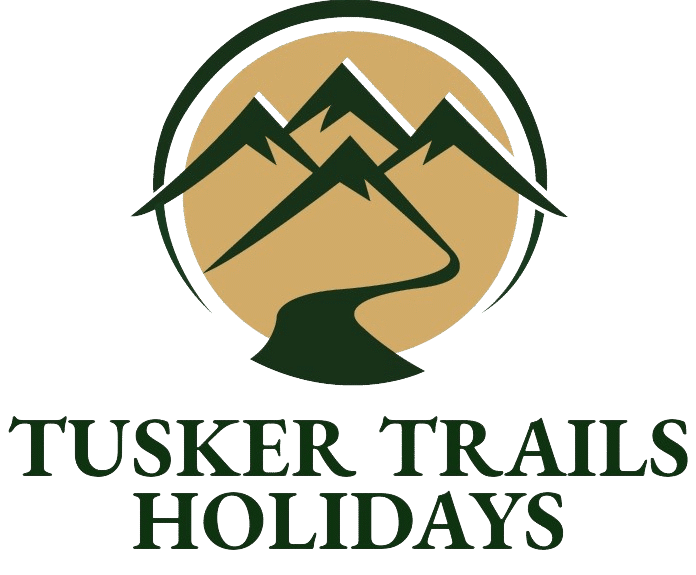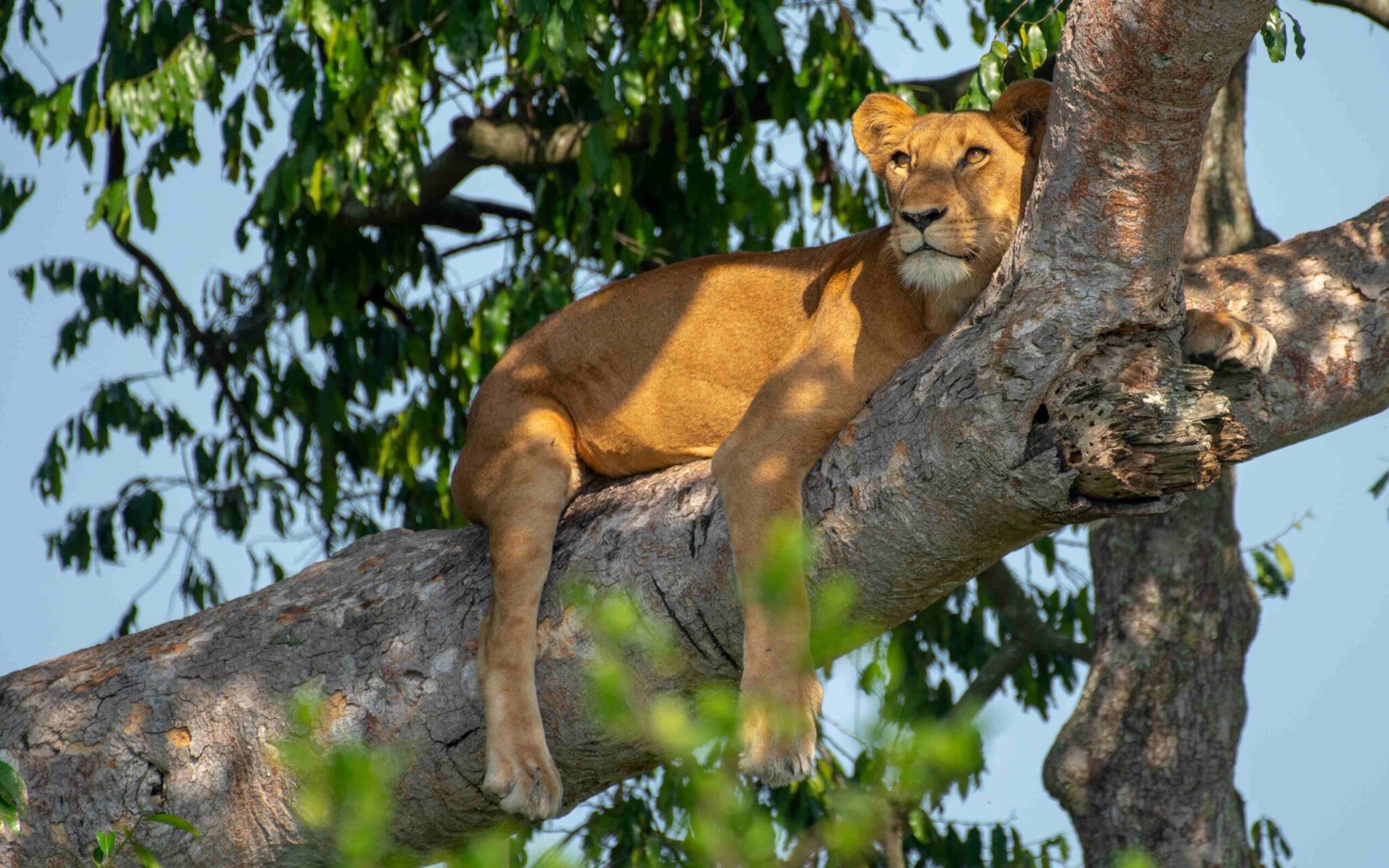Queen Elizabeth National Park is the perfect choice for travelers looking for a wildlife-rich destination in Uganda The Park covers an area of 1,978 square kilometers (764 square miles) in the Western Region of the country. It is Uganda’s most visited national park and one of the most biodiverse protected areas in Africa. The park boasts of stunning landscapes, diverse wildlife, and rich cultural heritage.
 Queen Elizabeth National Park was established in 1952 as Kazinga National Park and renamed two years later to commemorate a visit by Queen Elizabeth II. The park encompasses the districts of Kasese, Kamwenge, Rubirizi, and Rukungiri, and borders the Democratic Republic of the Congo to the west. The park is divided into four sections: Mweya Peninsula, Kasenyi Plains, Ishasha Sector, and Kyambura Gorge.
Queen Elizabeth National Park was established in 1952 as Kazinga National Park and renamed two years later to commemorate a visit by Queen Elizabeth II. The park encompasses the districts of Kasese, Kamwenge, Rubirizi, and Rukungiri, and borders the Democratic Republic of the Congo to the west. The park is divided into four sections: Mweya Peninsula, Kasenyi Plains, Ishasha Sector, and Kyambura Gorge.
The park is home to over 600 bird species, 10 primate species, and 95 mammal species, including the famous tree-climbing lions, elephants, buffaloes, hippos, leopards, hyenas, antelopes, crocodiles, and chimpanzees. The park also hosts several crater lakes, wetlands, forests, savannahs, and the Kazinga Channel that connects Lake George and Lake Edward.
Queen Elizabeth National Park is a destination that offers something for everyone. Whether you are looking for adventure, relaxation, education, or inspiration, you will find it here.
Wildlife in Queen Elizabeth National Park
One of the main attractions of Queen Elizabeth National Park is its abundant and diverse wildlife. The park has four of the Big Five animals: lions, elephants, buffaloes, and leopards. The fifth one, rhinos, can be found in Ziwa Rhino Sanctuary near Murchison Falls National Park.
The park is famous for its tree-climbing lions that can be seen in the Ishasha Sector. These lions have adapted to climbing fig and acacia trees to escape the heat and avoid insect bites. They also use the trees as vantage points to spot their prey. Seeing these lions lounging on tree branches is a unique and unforgettable sight.
 The park also has a large population of elephants that can be seen roaming around the savannahs and wetlands. These gentle giants are social animals that live in family groups led by a matriarch. They communicate with each other using low-frequency sounds that humans cannot hear. They also have a keen sense of smell and memory.
The park also has a large population of elephants that can be seen roaming around the savannahs and wetlands. These gentle giants are social animals that live in family groups led by a matriarch. They communicate with each other using low-frequency sounds that humans cannot hear. They also have a keen sense of smell and memory.
Another iconic animal of the park is the hippopotamus that can be seen in large numbers along the Kazinga Channel. These semi-aquatic mammals spend most of their time submerged in water to keep cool and protect their skin from sunburn. They emerge at night to graze on grasses and other vegetation. They are territorial and aggressive animals that can run faster than humans on land.
 The park also has a variety of antelopes that can be seen grazing on the grasslands. Some of the common species are kob, waterbuck, bushbuck, topi, eland, oribi, and duiker. These antelopes are preyed upon by predators such as leopards, hyenas, jackals, and cheetahs.
The park also has a variety of antelopes that can be seen grazing on the grasslands. Some of the common species are kob, waterbuck, bushbuck, topi, eland, oribi, and duiker. These antelopes are preyed upon by predators such as leopards, hyenas, jackals, and cheetahs.
The park is also a haven for birdwatchers as it has over 600 bird species recorded. Some of the notable birds are shoebill stork, African fish eagle, flamingo, pelican, kingfisher, bee-eater, hornbill, weaver, sunbird, and owl. The park has various habitats that support different kinds of birds such as wetlands, forests, savannahs, and lakes.
The park also has 10 primate species that can be seen in its forests and gorges. The most famous one is the chimpanzee that can be tracked in Kyambura Gorge and Kalinzu Forest Reserve. These intelligent apes share 98% of their DNA with humans and have complex social behaviors and communication skills. They use tools such as sticks and stones to obtain food and defend themselves.
Other primates that can be seen in the park are vervet monkey, olive baboon,
red-tailed monkey, black-and-white colobus monkey, L’Hoest’s monkey, blue monkey, potto, bushbaby, and red colobus monkey. These primates are active during the day and feed on fruits, leaves, insects, and sometimes meat.
Things to do in Queen Elizabeth National Park
Queen Elizabeth National Park offers a range of activities that cater to different interests and preferences. Some of the things you can do in the park are:
Game Drives
This is the best way to explore the park and see its wildlife. You can choose from morning, afternoon, or evening game drives that take you to different sections of the park. You can also opt for a customized game drive that suits your needs and expectations. You will be accompanied by a professional guide who will explain the park’s history, ecology, and culture.

Boat Cruise – Kazinga Channel
This is a relaxing and scenic way to enjoy the park’s aquatic life. You can take a boat cruise along the Kazinga Channel that connects Lake George and Lake Edward. You will see hundreds of hippos, crocodiles, buffaloes, elephants, and birds along the banks of the channel. You can also take a boat cruise on Lake George or Lake Edward to see more wildlife and fishing villages.
Chimp Tracking
This is an exciting and rewarding way to encounter one of our closest relatives in the wild. You can track chimpanzees in Kyambura Gorge or Kalinzu Forest Reserve with the help of experienced guides and rangers. You will follow their trails and listen to their calls until you find them. You will then spend an hour observing their behavior and interactions.
Birdwatching
This is a perfect activity for nature lovers and enthusiasts. You can go birdwatching in various habitats of the park such as wetlands, forests, savannahs, and lakes. You will see a variety of birds such as shoebill stork, African fish eagle, flamingo, pelican, kingfisher, bee-eater, hornbill, weaver, sunbird, and owl. You will also learn about their identification, distribution, and conservation.
Cultural Tours
This is a great way to learn about the local people and their culture. You can visit the salt mining community of Lake Katwe and see how they extract salt from the lake using traditional methods. You can also visit the traditional homesteads of the Basongora pastoralists and see their cattle and crafts. You can also enjoy energetic musical and dance performances by the Kikorongo Equator Performers.
Frequently Asked Questions
Here are some of the common questions that visitors ask about Queen Elizabeth National Park:
When is the best time to visit Queen Elizabeth National Park?
The best time to visit Queen Elizabeth National Park is during the dry seasons from December to February and from June to August. During these periods, the roads are more accessible, the wildlife is more concentrated around water sources, and the visibility is better. However, you can visit the park any time of the year as it has a pleasant climate throughout.
What are the accommodation options in Queen Elizabeth National Park?
There are various accommodation options in Queen Elizabeth National Park that suit different budgets and preferences. You can choose from luxury lodges, mid-range hotels, budget campsites, or homestays. Some of the popular places to stay in the park are:
Mweya Safari Lodge
This is a luxury lodge located on the Mweya Peninsula overlooking the Kazinga Channel. It has spacious rooms, suites, cottages, and tents with en-suite bathrooms and balconies. It also has a restaurant, bar, swimming pool, spa, gift shop, conference center, and airstrip.
Ishasha Wilderness Camp
This is another luxury camp located in the Ishasha Sector near the river Ntungwe. It has 10 comfortable tents with en-suite bathrooms and verandas. It also has a dining area, lounge, bar, fire pit, and solar power.
Simba Safari Camp
This is a budget camp located near the Kasenyi Plains. It has 8 dormitory rooms, 7 twin rooms, and 2 family cottages with shared bathrooms. It also has a restaurant, bar, lounge, and campfire.
Enjojo Lodge
This is a homestay located in Ishasha Sector near Lake Edward. It has 5 cottages with en-suite bathrooms and verandas. It also has a restaurant, bar, garden, and swimming pool.
How do I get to Queen Elizabeth National Park?
There are two main ways to get to Queen Elizabeth National Park:
By road
You can drive from Kampala to Queen Elizabeth National Park via Masaka, Mbarara, and Bushenyi. The journey takes about 6 hours on good roads. You can also drive from Kigali in Rwanda to Queen Elizabeth National Park via Katuna, Kabale, and Kisoro. The journey takes about 7 hours on good roads.
By Flight
There are several domestic airlines that offer scheduled and charter flights from Entebbe International Airport or Kampala’s Kajjansi Airfield to airstrips near the park, such as Kasese, Mweya or Ishasha. The flight time is about 1 hour and the cost ranges from $200 to $400 per person one way depending on the airline and the season.


